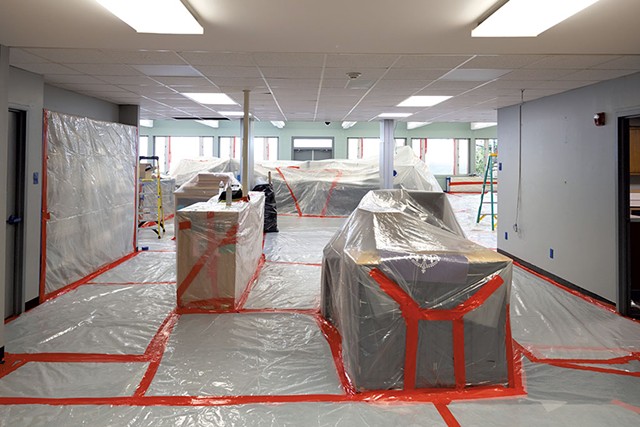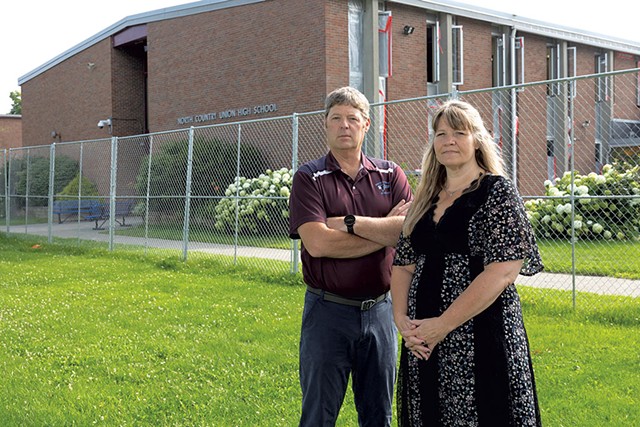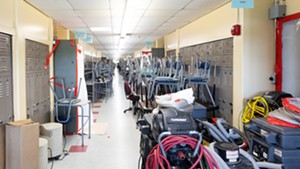
- Don Whipple
- North Country Union High School's library, wrapped in plastic
North Country Union High School was built when Lyndon B. Johnson was president. Its 55-year-old windows and doors need to be replaced, according to a facilities assessment completed last year. The heating and electrical systems are due for an overhaul. Classrooms are small and outdated.
"It's just not suitable for 21st-century education," principal Chris Young said. "We've maintained it well ... But it's outlasted its useful life."
Instead of undertaking construction projects that would improve the building, however, frustrated administrators in the Newport-based district are deep into an expensive state-mandated initiative to remove PCBs. The toxic chemicals were detected at high levels in the air in spring 2023, and school officials hope a $5 million remediation project this summer will improve the situation.
But test results won't be back until just after school starts. That has North Country administrators working to get confirmation from the state that they'll be able to use even parts of the building — or figure out an alternative plan for students if PCB levels are still high.
"What we don't want to have happen is to get to the end of August and look at results after doing a $5 million project and have [the state] say, 'Whoops, you can't actually be in the building,'" superintendent Elaine Collins said.
Of the Vermont school buildings that have been tested for airborne PCBs since 2022 — an initiative prompted by the discovery of the chemicals at Burlington High School in 2020 — North Country's contamination is the most serious and widespread. But trying to fix it has ushered in a host of other problems, including disruptions and uncertainty for administrators, teachers and families. That's the case not just at North Country but in other districts across the state.
An initiative that was created to keep kids and faculty safe has in some districts led to a quagmire.
Around 350 schools in Vermont, all built before 1980, qualify for testing. Of the 136 tested so far, 44 have airborne PCB levels that require further action under state guidelines. Most have not been fully remediated yet. The Department of Environmental Conservation, which is overseeing the project, must sign off on any work schools do. Getting results for air and materials testing can take weeks.
In the Mill River Unified Union School District, air testing last year showed that both Clarendon and Wallingford elementary schools had elevated levels of PCBs. The Clarendon library and some classroom space had to be closed; gym use has been limited. In Wallingford, pre-K students had to swap classrooms with older students, which required some plumbing and maintenance work to create appropriate spaces for smaller children.
Superintendent Brian Hill had hoped PCB mitigation would be finished this summer so that school operations could return to normal when the new year started. But he's learned that the DEC won't authorize additional testing that must be done before remediation can start, putting his district in a holding pattern.
"We have been told we're not a priority," Hill said. He's prepared to start the school year with the same space limitations in place and no plan for moving forward.
Rebecca Fillion, principal of Twin Valley Elementary School in Wilmington, is dealing with a delay as well. PCBs were found in her school in March 2023. Carbon air filtration units were installed last year as a way to lower the airborne levels — but airborne results came back higher. Fillion had hoped another project, to improve ventilation, would have been completed so that the school gym could reopen.
"Sadly, it's mid-July and we are still in the planning phase," Fillion wrote in an email to Seven Days earlier this month.
At Bellows Falls Union High School, which has been contending with its own PCB problems for the past year, it's unclear whether the state will allow students to use the gym or locker rooms when school opens, according to Windham Northeast superintendent Andy Haas. Just in case, he said, they're making contingency plans for preseason and fall sports.
Rep. Peter Conlon (D-Cornwall), chair of the House Education Committee, is watching the various situations unfold across the state with dismay. He tried this year and last to pass legislation that would pause the PCB testing program. But the plan met resistance from the Senate and Gov. Phil Scott's administration. Sen. Brian Campion (D-Bennington), chair of the Senate Education Committee, has been a strong advocate for the program, but he won't be returning to the legislature next year.
Still, Conlon said, "I'm not sure there's a whole lot more I can do."
"How many years into this are we now?" he added. "And not a single state has said, 'Oh, [Vermont] had a good idea. Let's copy them.'"
North Country's saga started in spring 2023, when testing showed that airborne PCB levels in dozens of classrooms were higher than the Vermont Department of Health allows. Ten rooms exceeded the state's "immediate action level" of 300 nanograms per cubic meter, meaning that no students or staff could occupy the space.
Under the direction of a state-hired consultant, the district undertook multiple PCB mitigation projects last school year that cost nearly $1 million.
But follow-up air testing this June showed that PCB levels had actually soared in some spaces, according to Collins — in many cases, way over the state's immediate action level.
This summer, North Country is embarking on its biggest mitigation effort yet. It includes painting over PCB-laden surfaces and grinding down caulk on windows at a cost of $5 million — money that will come from a dwindling pot of funds set aside by the legislature to address PCB contamination. After the North Country project is complete, only $870,000 will remain in the state education fund for remediation work, according to the Agency of Education director of operations Jill Briggs Campbell — a fraction of what further projects will cost.

- Don Whipple
- North Country principal Chris Young and superintendent Elaine Collins
The project won't be finished until mid-August, just about a week before the new school year starts. After that, another round of air testing will occur. Both Collins and Young said they are concerned that if PCB levels remain high, the health department will order them to shutter the school and they'll have to scramble to find alternative spaces for learning. Young said the Agency of Education is working to help the district secure trailers just in case.
The administrators worry about the toll that a chaotic start to the school year would take on their approximately 720 high school students, who have already experienced pandemic-related education disruptions. The district has asked the health department to issue an occupancy letter for the building that outlines which spaces are usable if air testing results don't improve. Rep. Erin Brady (D-Williston), vice chair of the House Education Committee, and Conlon also wrote to state officials urging them to provide guidance.
"Without clear direction from the [health department], the school administrators are placed in an untenable situation where they must interpret the rules of the program and guess what the [health department] requirements for occupancy might be, or relay what someone told them on the phone," Conlon and Brady wrote in the July 18 memo. "That is, frankly, unacceptable as these educators deal with all that is being thrown at them with this program that they did not ask for."
But in a joint statement to Seven Days, the departments of health and environmental conservation said they will not provide an occupancy letter until the current PCB project and another round of testing is completed.
"It is anticipated that the [project] will result in a meaningful reduction in PCBs indoor air levels," the statement said. "We are prepared to support the school to ensure the educational, health, and mental health needs of its students are being met."
Young said he and Collins had a productive meeting with state officials on Monday, and he feels like they are starting to understand the situation from the school's perspective. Still, the administrators aren't fully reassured.
"While I would like to believe that the mitigation work will result in a reduction in PCB indoor air levels, I can't plan for a school opening based on what the [health department] anticipates, especially given the lengthy turnaround time for results to be validated and reported back to the school," Young wrote in an email.
The best way for the state to support his students' educational, physical and mental health needs, he added, "will be to work with us to open school on-time and in-person."















Comments
Comments are closed.
From 2014-2020, Seven Days allowed readers to comment on all stories posted on our website. While we've appreciated the suggestions and insights, right now Seven Days is prioritizing our core mission — producing high-quality, responsible local journalism — over moderating online debates between readers.
To criticize, correct or praise our reporting, please send us a letter to the editor or send us a tip. We’ll check it out and report the results.
Online comments may return when we have better tech tools for managing them. Thanks for reading.